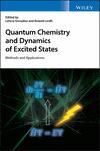Gaussian Wave Packets and the DD-vMCG Approach
Summary
This chapter provides an overview of the variational multi-configurational Gaussian (vMCG) approach, which belongs to the family of Gaussian wave packet (GWP) methods. It is based on similar grounds to the spawning and related approaches (see Chapter Full and Ab Initio Multiple Spawning), but has explicit coupling between the GWP quantum amplitudes. This means that it relies on “quantum trajectories” followed by the centers of the GWPs, rather than classical ones. By this, it is to be understood that the mean positions and momenta are specifically obtained from equations of motions derived from a variational solution to the time-dependent Schrödinger equation (TDSE), in addition to the expansion coefficients, thus resulting in a favorable convergence on the exact solution. GWP methods are attractive ways to solve the TDSE, alternative to grid-based methods such as the multi-configurational time-dependent Hartree (MCTDH) approach (see Chapter Multi‐Configuration Time‐Dependent Hartree Methods: From Quantum to Semiclassical and Quantum‐Classical). Their main advantage is that they provide a way to run direct dynamics with quantum nuclei, whereby the potential-energy surfaces and non-adiabatic couplings are calculated on-the-fly, much as in trajectory-based approaches (see Chapters Gaussian Wave Packets and the DD‐vMCG Approach–Exact Factorization of the Electron–Nuclear Wave Function: Theory and Applications). This is achieved via an interface between quantum-dynamics and quantum-chemistry programs. The direct dynamics variant of vMCG is known as DD-vMCG. The implementation of the method and its performance will be illustrated with three examples: salicylaldimine to show phase-space coverage and tunneling, the butatriene cation to demonstrate how it works within a non-adiabatic context, and formamide to exemplify direct dynamics.



